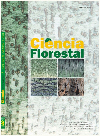
|
Ciência Florestal
Centro de Pesquisas Florestais - CEPEF, Departamento de Ciências Florestais - DCFL, Programa de Pós Graduação em Engenharia Florestal - PPGEF
ISSN: 0103-9954
EISSN: 0103-9954
Vol. 23, No. 1, 2013, pp. 165-174
|
 Bioline Code: cf13015
Bioline Code: cf13015
Full paper language: English
Document type: Research Article
Document available free of charge
|
|
|
Ciência Florestal, Vol. 23, No. 1, 2013, pp. 165-174
| en |
RELATIONSHIP BETWEEN CONCENTRATIONS OF TOTAL SOLUBLE CARBOHYDRATES IN THE LEAVES AND COLD TOLERANCE IN DIFFERENT SPECIES OF Eucalyptus  spp. spp.
Floriani1, Mireli Moura Pitz; Steffens, Cristiano André; Chaves, Djalma Miler; do Amarante, Cassandro Vidal Talamini; Pikart, Tiago Georg & Ribeiro, Maitê dos Santos
Abstract
This work was carried out to evaluate the effects of the rustification on cold tolerance in Eucalyptus dunnii

Maiden, Eucalyptus benthamii

Maiden & Cambage, Eucalyptus grandis

W. Hill ex Maiden, and Eucalyptus saligna

Sm., by quantifying leaf contents of total soluble carbohydrates and proline. Seedlings (three months old and about 50 cm height) of these species were submitted to two periods of rustification (zero and 21
days exposure to day/night temperatures of 5 °C/1 °C), with photoperiod of 12 hours. After each period of
rustification, the seedlings were submitted, for 3 hours, to three temperatures below 0 °C (-2 °C, -5 °C, and
-8 °C). The seedlings were then assessed for leaf contents of total soluble carbohydrates and proline, lethal
temperature of 50 % (LT 50), and cold damage index. Proline was not detected in the leaves of all species.
However, in non-rustified seedlings, there were differences between the species regarding to the foliar
contents of carbohydrates, with the highest values in Eucalyptus benthamii, intermediary in Eucalyptus
dunnii and Eucalyptus grandis, and the lowest in Eucalyptus saligna. The rustification treatment increased
leaf concentration of total soluble carbohydrates by 2.9, 2.5, 2.8, and 1.3 in Eucalyptus dunnii, Eucalyptus
benthamii, Eucalyptus saligna and Eucalyptus grandis, respectively. In the seedlings not submitted to the
rustification, the LT 50 value was lower in Eucalyptus benthamii, intermediary in Eucalyptus dunnii and
Eucalyptus grandis, and higher in Eucalyptus saligna. However, in rustified seedlings the LT 50 was no
different among the species. Rustification reduced the LT 50, except in Eucalyptus benthamii. There was a
negative correlation between leaf concentration of total soluble carbohydrates and the LT 50, considering all
Eucalyptus species evaluated. The results show that leaf concentration of total soluble carbohydrates can be
used as an indicator of cold tolerance in species of Eucalyptus.
lethal temperature of 50 % (LT50); acclimatization, sub-zero temperature; cold damage
|
| |
| pt |
FLORÍSTICA E ESTRUTURA DO COMPONENTE ARBÓREO E ANÁLISE AMBIENTAL DE UM FRAGMENTO DE FLORESTA OMBRÓFILA MISTA ALTO-MONTANA NO MUNICÍPIO DE PAINEL, SC
Floriani1, Mireli Moura Pitz; Steffens, Cristiano André; Chaves, Djalma Miler; do Amarante, Cassandro Vidal Talamini; Pikart, Tiago Georg & Ribeiro, Maitê dos Santos
Resumo
O objetivo deste trabalho foi avaliar o efeito da rustificação sobre a tolerância ao frio em Eucalyptus dunnii

Maiden, Eucalyptus benthamii

Maiden & Cambage, Eucalyptus grandis

W. Hill ex Maiden, e Eucalyptus saligna

Sm., através da quantificação dos teores foliares de carboidratos solúveis totais e de prolina. Mudas
das quatro espécies (com três meses de idade e cerca de 50 cm de altura) foram submetidas a dois períodos
de rustificação (0 e 21 dias de exposição a temperaturas diurnas de 5 °C e noturnas de 1 °C), com fotoperíodo
controlado de 12 horas. Ao final de cada período de rustificação, as mudas foram submetidas durante 3
horas a três gradientes de temperatura abaixo de zero (-2 °C, -5 °C e -8 °C). Foram feitas avaliações das
concentrações foliares de carboidratos solúveis totais e de prolina, da temperatura letal de 50 % (TL 50) e do
índice de dano ao frio. Não foi identificada a presença de prolina nos tecidos foliares das espécies avaliadas.
No entanto, em mudas não rustificadas, observou-se diferenças entre as espécies quanto à concentração
foliar de carboidratos, sendo maior em Eucalyptus benthamii, intermediária em Eucalyptus dunnii e
Eucalyptus grandis, e menor em Eucalyptus saligna. A rustificação causou um aumento na concentração
foliar de carboidratos de 2,9; 2,5; 2,8 e 1,3 vezes em Eucalyptus dunnii, Eucalyptus benthamii, Eucalyptus
saligna e Eucalyptus grandis, respectivamente. Em mudas que não foram submetidas à rustificação, a
TL 50 foi mais baixa em Eucalyptus benthamii, intermediária em Eucalyptus dunnii e Eucalyptus grandis,
e mais alta em Eucalyptus saligna. No entanto, com a rustificação das plantas não houve diferenças entre
as espécies quanto à TL 50. Observou-se que a TL 50 diminuiu com a rustificação, exceto no Eucalyptus
benthamii. Houve correlação negativa entre a concentração foliar de carboidratos solúveis totais e a TL 50
nas espécies avaliadas. Os dados obtidos mostram que a concentração foliar de carboidratos solúveis totais
pode ser utilizada como indicador de tolerância ao frio em espécies de Eucalyptus.
temperatura letal de 50 % (TL50); aclimatação; temperatura negativa; dano por frio
|
| |
© Copyright 2013 - Ciência Florestal
Alternative site location: http://cascavel.ufsm.br/revistas/ojs-2.2.2/index.php/cienciaflorestal/index
|
|
